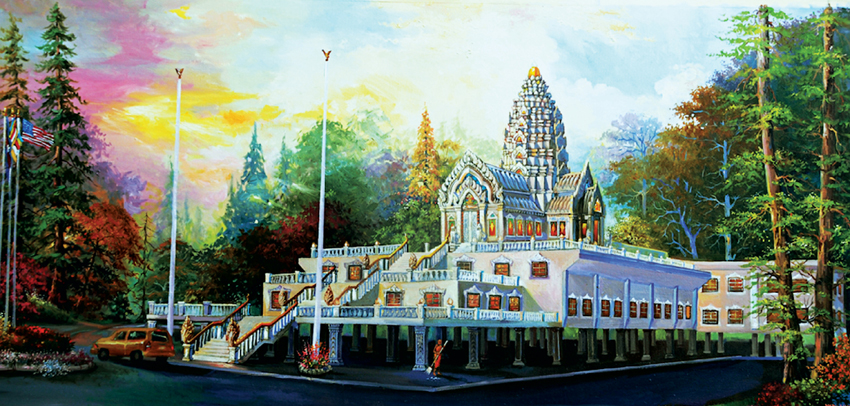Sex and the Single Monk

Still-frame images from a tape that allegedly shows a Lowell monk having sex.
The Cambodians who began moving to Lowell in the early 1980s followed a well-worn path laid by the Irish, the French-Canadians, and the Greeks who had come before them. Unlike these earlier waves of immigrants, however, the Cambodians arrived as refugees, fleeing a Khmer Rouge regime responsible for killing as many as 2.5 million people. The city they settled in, once a booming center of textile manufacturing, had long since seen its mills go dark. Assimilation for Cambodian immigrants was a decades-long struggle. Their community was plagued by gang violence, drugs, unemployment, and the lingering cultural trauma of genocide. More recent years, though, have been kinder.
The community is clustered in a neighborhood called the Lower Highlands, where signs written in Khmer line a gritty business district of shops and restaurants that’s sometimes referred to as Cambodia Town. Yet the people who live in the area have lately become quite assertive in joining the rest of the city and the wider world. Jumping into the bare-knuckle, clannish slugfest that is Lowell politics, they’ve elected two Cambodians to the city council since 1999, and may vote to send a third there next month. Today, Lowell is home to as many as 35,000 Cambodians, a third of the city’s population and the second-largest such community in the country, behind only the one in Long Beach, California.
The Cambodians who arrived 30 years ago as refugees, in other words, are now integrated into the fabric of Lowell. And so in 2011, they announced a plan to build a gleaming house of worship to herald their arrival, much as the immigrant communities before them had erected churches and synagogues. The Vatt Khmer Lowell would be built in a style reminiscent of Angkor Wat, the 900-year-old temple complex that is Cambodia’s most famous monument. The brainchild of an organization called the Community of Khmer Buddhist Monks, the $10 million temple would be a gleaming white structure on stilts, its scalloped stupa—a pagoda-like tower—rising over a forest clearing near the Merrimack River. It would serve as a place of worship, a monastery for monks from Cambodia and other countries, and a cultural center for Khmer arts, history, and language. Perhaps most important, though rarely spoken of in non-Cambodian circles, was the hope that the temple would also help unite an immigrant community with a history of ugly feuding.

An artist’s rendering of the proposed temple, which was to be built in the style of Angkor Wat, Cambodia’s most famous monument.
Lowell’s Community of Khmer Buddhist Monks, known as the CKBM, established a board to oversee its temple project, and selected one of its members, the highly regarded Buddhist scholar Nhem Kimteng, to join the executive committee. Among a number of other board members was Maya Men, a CKBM volunteer who had moved to the city a couple of years earlier from Providence. Men told me that her passion for the project in Lowell stemmed from a treatment of “special herbs” that the CKBM’s head monk, the Venerable Sao Khon, had used to heal her after she was diagnosed with cancer in 2008 and given just months to live. After that, she told me, “I promised myself if I have energy, anything, I would help the temple.”
To round out the board, the CKBM recruited professionals and other Cambodians from outside the insular religious community. Emerging as a leader of this faction was a charismatic financial consultant and fledgling politician named Sam Meas. From the outset, Meas told me, he recognized a kind of cultural disconnect on the board. Practices he’d learned in the business world seemed lost on the CKBM monks. “I had to explain taking minutes,” he said. “They didn’t have their books in order.” Still, he, Maya Men, and the prominent community leader Samkhann Khoeun presented a united front when they sat down for a video-recorded interview with the editor of the Lowell Sun to explain the project and solicit support from the general public. “With respect to transparency,” Meas told the editor, glancing at his colleagues on his left and right, “we’ll be documenting everything that’s coming in and going out.” Meas would later tell me that his interest in the temple “was selfish in a way. I want to make Cambodian Americans proud of what we have. We don’t have a Cambodian school, we don’t have a cultural center to teach the Cambodian-American culture.” The temple, he said, would be more than a place of worship, it would be a symbol of unity.
Instead, nearly three years after it was first conceptualized, the project has reopened old wounds and ripped Lowell’s Cambodian community apart. Lawsuits have been filed with sordid allegations of financial improprieties involving CKBM and, most shocking, videotaped sexual hijinks involving a monk. Far from making an emergent community proud, the temple has so far been a source of outrage and embarrassment for the city’s Cambodians.
The CKBM was founded in 1994 by the Venerable Sao Khon, who was born in a village near Ankgor Wat in 1934. Wiry and intense, Khon has traveled the world as a leading figure in the Engaged Buddhism movement, which applies the principles of the religion to promote human rights and social justice. Khon started the CKBM in an effort to create a national network of Cambodian temples and a hierarchy of monks—a kind of Buddhist Vatican. The precise number of CKBM temples is not known, but there are a handful in the region. And when plans for the Vatt Khmer Lowell were announced in early 2011, it was envisioned as the largest and finest Buddhist temple in the country.


